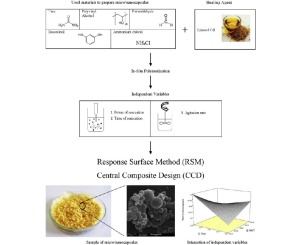Particuology ( IF 3.5 ) Pub Date : 2017-06-20 , DOI: 10.1016/j.partic.2017.01.010 Ali Ebrahiminiya , Mohammad Khorram , Shadi Hassanajili , Mehdi Javidi

|
Micro/nanocapsules of urea–formaldehyde resin loaded with linseed oil, which are a self-healing agent in glass flake epoxy anti-corrosion paint, were prepared using a combination of ultrasonic homogenization and in-situ polymerization. The main objective of this study was to model and optimize the microencapsulation process. Five-level central composite design was used to design, model, and optimize the microencapsulation process. A quadratic model was constructed to show the dependency of the percentage of encapsulated linseed oil and capsule size, as model responses, on the studied independent variables (the rotational speed of the agitator and the power and duration of sonication). Analysis of variance showed that all of the variables have significant effects on the encapsulated linseed oil percentage, while the rotational speed of the agitator and sonication time is effective variables for controlling the capsule size. Under the determined optimum conditions, a maximum encapsulated linseed oil percentage (ELO%) of 93.9% and a minimum micro/nanocapsule size of 0.574 μm were achieved at 594 rpm agitation, 350 W sonication power, and 3 min sonication time. Validation of the model was performed. The percentage relative errors between the predicted and experimental values of the ELO% and micro/nanocapsule size are 1.28% and 3.66%, respectively. The efficacy of the optimum micro/nanocapsules in healing cracks in a glass flake epoxy paint and corrosion protection was investigated by the salt spray test and Tafel polarization technique.
中文翻译:

影响生产基于环氧的自修复防腐涂料的原位微囊化工艺的参数的建模和优化
超声均质化和原位聚合相结合,制备了亚麻籽油中负载的亚麻籽油的脲醛树脂微/纳米胶囊,它们是自修复剂。这项研究的主要目的是建模和优化微囊化过程。使用五级中央复合设计来设计,建模和优化微囊化过程。构建了一个二次模型,以显示封装的亚麻籽油百分比和胶囊大小作为模型响应对所研究的独立变量(搅拌器的转速以及超声处理的功率和持续时间)的依赖性。方差分析表明,所有变量均对封装的亚麻籽油百分比具有显着影响,搅拌器的转速和超声处理时间是控制胶囊尺寸的有效变量。在确定的最佳条件下,在594 rpm搅拌,350 W超声处理功率和3分钟超声处理时间下,获得的最大包封亚麻籽油百分比(ELO%)为93.9%,最小微/纳米颗粒尺寸为0.574μm。进行模型验证。ELO%和微/纳米胶囊大小的预测值与实验值之间的相对误差百分比分别为1.28%和3.66%。通过盐雾试验和Tafel极化技术研究了最佳微/纳米胶囊在修复玻璃鳞片环氧涂料中的裂纹和腐蚀防护方面的功效。在594 rpm的搅拌,350 W的超声处理功率和3分钟的超声处理时间下,最大包封的亚麻籽油百分比(ELO%)为93.9%,最小微/纳米颗粒尺寸为0.574μm。进行模型验证。ELO%和微/纳米胶囊大小的预测值与实验值之间的相对误差百分比分别为1.28%和3.66%。通过盐雾试验和Tafel极化技术研究了最佳微/纳米胶囊在修复玻璃鳞片环氧涂料中的裂纹和腐蚀防护方面的功效。在594 rpm的搅拌,350 W的超声处理功率和3分钟的超声处理时间下,最大包封的亚麻籽油百分比(ELO%)为93.9%,最小微/纳米颗粒尺寸为0.574μm。进行模型验证。ELO%和微/纳米囊大小的预测值与实验值之间的相对误差百分比分别为1.28%和3.66%。通过盐雾试验和Tafel极化技术研究了最佳微/纳米胶囊在修复玻璃鳞片环氧涂料中的裂纹和腐蚀防护方面的功效。ELO%和微/纳米胶囊大小的预测值与实验值之间的相对误差百分比分别为1.28%和3.66%。通过盐雾试验和Tafel极化技术研究了最佳微/纳米胶囊在修复玻璃鳞片环氧涂料中的裂纹和腐蚀防护方面的功效。ELO%和微/纳米胶囊大小的预测值与实验值之间的相对误差百分比分别为1.28%和3.66%。通过盐雾试验和Tafel极化技术研究了最佳微/纳米胶囊在修复玻璃鳞片环氧涂料中的裂纹和腐蚀防护方面的功效。



























 京公网安备 11010802027423号
京公网安备 11010802027423号